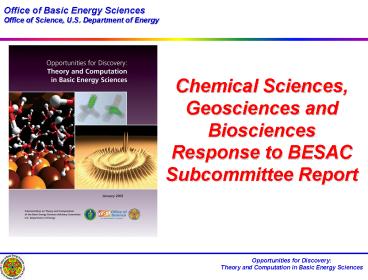Chemical Physics - PowerPoint PPT Presentation
1 / 9
Title:
Chemical Physics
Description:
Opportunities for Discovery: Theory and Computation in Basic Energy Sciences ... Identified Areas of Opportunity. Nanoscience. Correlated Electrons in Solids ... – PowerPoint PPT presentation
Number of Views:204
Avg rating:3.0/5.0
Title: Chemical Physics
1
Office of Basic Energy Sciences Office of
Science, U.S. Department of Energy
Chemical Sciences, Geosciences and Biosciences
Response to BESAC Subcommittee Report
2
Report Provides a Very Compelling Case
- Increased support for theory and computation
would enhance and complement the substantial BES
investments in experimental science and
facilities. - Investment is necessary to capitalize on recent
investments in Tabletop science and Laboratory
Facilities ALS, APS, SNS, Nanotechnology
Centers.. - Exciting new frontiers are emerging in
nanoscience, ultrafast science, quantum control
and information, biomimetics Theory and
computation are essential to provide fundamental
understanding. - Increased computational capability offered by
ultrascale computing will enable many new
advances.
3
Identified Areas of Opportunity
- Nanoscience
- Correlated Electrons in Solids
- Electronically Excited States
- Defects in Solids
- Control of Energy, Matter and Information at the
Quantum Level - Ultrafast Physics and Chemistry
- Magnetic Spin Systems and Single-Electron Devices
- Biomimetic Materials and Energy Processes
- Control of Chemical Transformations
4
High-End Computing Resources are a Limiting
Factor
- SUBCOMMITTEE RECOMMENDATION BES should become
strongly engaged with the DOE Office of Advanced
Scientific Computing Research to ensure that
large amounts of time on terascale capacity
facilities are available to the BES scientific
community. Also, BES should consider supporting
some of this capacity with local institutional
computing, while ensuring that demand at the
higher end of computing power is supplied by
larger facilities. - At the present time availability of DOE Computing
resources is seriously impeding the progress of
research. The current demand exceeds supply of
available resources by factors of 3-5. - There is a continuing dialog between BES Program
Managers and ASCR on issue of computing
resources. - BES is already supporting clusters in conjunction
with laboratory and academic research programs.
5
Software as Shared Research Infrastructure
- SUBCOMMITTEE RECOMMENDATION BES should support
the development and maintenance of scientific
codes in the disciplines in its portfolio, just
as it now funds the development of shared
beamlines at its experimental facilities, thereby
creating new scientific capabilities for the
nation. Such investments will also be critical in
allowing BES researchers to take full advantage
of the capabilities of DOEs leadership-class
computing facilities. - Will BES researchers be ready for
leadership-class computing facilities? - SciDAC 01-08 was a good start. TMS in
Nanoscience 03-17 was also an important BES
investment. - Community needs to identify the strategic needs.
- What is the correct support model? Similar to
beamlines and endstations? Finite duration
development projects with milestones and
deliverables? Computational Material Science
Network. Model similar to UK Collaborative
Computational Projects (CCPs)?
6
Balance and Impact of Support Within Realistic
Funding Constraints
- Balance between single-PI funding and large scale
collaborative research projects. - Balance between investments in university
research versus laboratory research. - Balance between support of basic research and
investments in research infrastructure (software
development).
7
Bill Lester, LBNL , 2004 INCITE Award
8
Jacqueline Chen, 2005 INCITE Award
- S3D Simulation Accomplishments
- Autoignition
- Temperature effect on inhomogeneities at constant
pressure - Temperature effect on inhomogeneities under HCCI
conditions (fixed volume) - Strain effect on transient ignition of H2/air in
counterflow - Strain effect on transient ignition of
n-heptane/air at high pressure in counterflow - Turbulent jet flames
- Differential diffusion quantification
- A priori testing of reacting/mixing models for
LES of combustion - Turbulent premixed flames
- H2-enriched lean premixed turbulent methane/air
flames stability, CO - Turbulent curvature stretch effects in the
thin-reactions zone regime - DNS numerical algorithms
- Improved NSCBC boundary condition treatment for
compressible reacting flows - High-order implicit-explicit additive Runge-Kutta
method
9
Chemical Sciences, Geosciences and Biosciences
Division is Committed to Increasing Support for
Theory and Computing.
- In FY 2005 CSGB set aside a 1M division reserve
to fund new starts in Theory and Computation. 7
new Theory and Computing starts between the
Chemical Physics and AMOS Programs. - CSGB will set aside a division reserve again in
FY 2006 for the same purpose. - CSGB will be guided in its future support of
Theory and Computing by the recommendations in
this subcommittee report.































